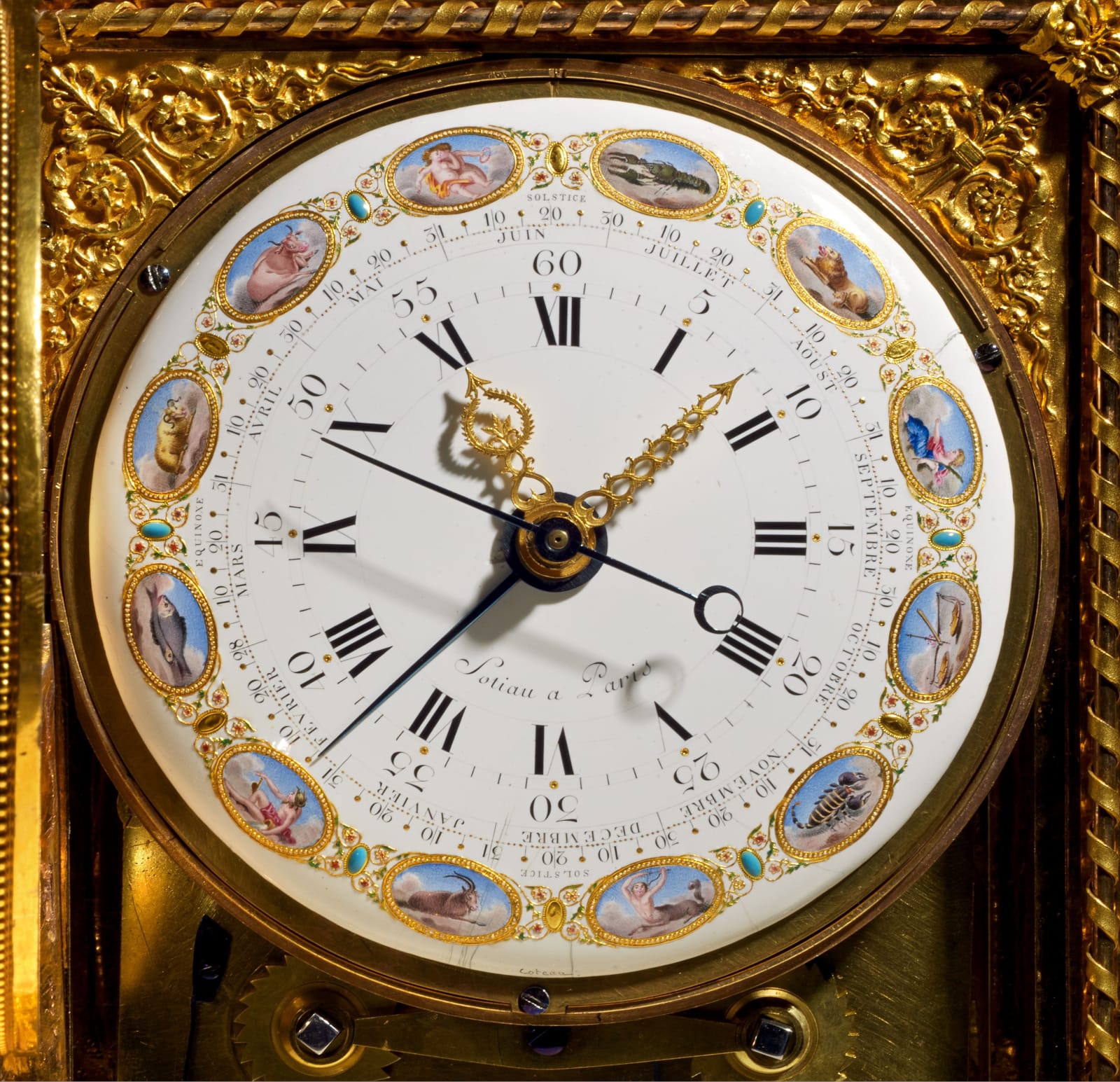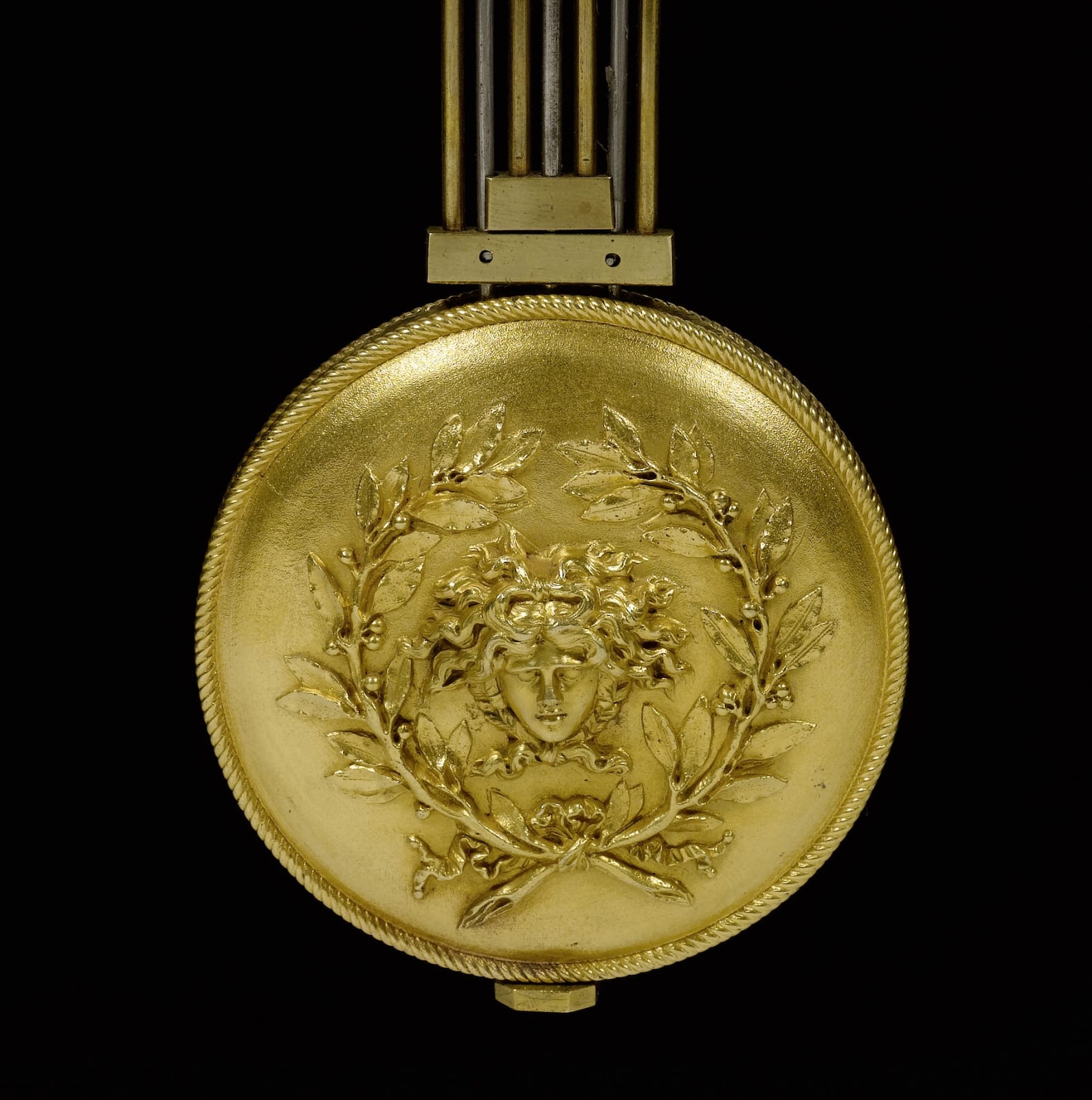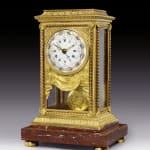Renacle-Nicolas Sotiau
Further images
Provenance
Jacques Seligmann, Paris. Mary Stuart Hanna. Her deceased sale, Parke-Bernet, New York, 26th January 1946, lot 63. Acquired by a private collector thence by descent until very recent years.
Literature
Tardy, "Les Plus Belles Pendules Françaises", 1994, p. 201, illustrating a very fine regulator with a very similar enamelled dial by Joseph Coteau, in a comparable gilt bronze case with a movement by the royal clockmaker Robert Robin. Pierre Kjellberg, "Encyclopédie de la Pendule Française du Moyen Age au XXe Siècle", 1997, p. 312, pl. A, illustrating a skeleton clock with a cut-out dial by Coteau with very similar painted decorations.
A magnificent Louis XVI gilt bronze and white veined red marble table regulator of fourteen day duration, signed on the dial Sotiau à Paris and also Coteau below 6 o'clock and on the reverse, the exquisitely gilt and polychrome painted dial by Joseph Coteau with Roman and Arabic numerals for the hours and minutes, a calendar ring with the names of months and their relevant days 10/20/28, 30 or 31 as well as solstice and equinoxe, with a beautiful outer ring with painted images of the twelve signs of the zodiac within oval gilt beaded lozenges interspersed by turquoise jewelled medallions within foliate scrolls, with an extremely beautiful pair of pierced gilt brass hands for the hours and minutes and blued steel pointers for the calendar indications and sweep centre seconds. The movement with knife edge suspension, pin wheel escapement, striking on the hour and half hour on a bell. The elaborately gilt bronze plinth case of rectangular form, glazed on all sides, with a stepped top cast with an anthemion over an egg-and-dart border, the case framed with rods encircled by ribbon motifs with anthemion at each corner, cast below the dial with a pair of outward facing sphinxes hung with a drapery swag above the pendulum aperture revealing the beautiful large gilt bronze pendulum bob cast on both sides with a Medusa head encircled within laurel leaf branches, the stepped plinth with an acanthus border on a rectangular white veined red marble base on bun feet
Paris, date circa 1785
Height 44.5 cm, width 29 cm, depth: 22.5 cm.
The importance of this clock not only rests upon the name of its maker Renacle-Nicolas Sotiau (1749-91) but also on the beauty of the jewelled dial executed by the renowned enamellist Joseph Coteau (1740-1812) as well as the splendour of the case. Added to this it was once in the collection of the well respected Paris dealer Jacques Seligmann and then owned by Mary Stuart Hanna, third wife and divorcee of the Cleveland millionaire publisher Dan R. Hanna.
According to J-D Augarde: "For ten years [Sotiau] was one of the most famous clockmakers in Paris. Born in Liège, he was received as a Parisian maître-horloger in 1782. Based at rue Saint-Honoré, he held the title of Horloger de Mgr le Dauphin, (Louis XVI's son). Much of his work was commissioned by the marchands-merciers Dominique Daguerre and François Darnault and were owned by some of the richest and most powerful people of their day, namely Louis XVI and Marie-Antoinette as well as Louis XV's daughters, Mesdames Victoire and Adelaïde, the ducs de Choiseul, de Polignac and de Praslin, the marquise de Brunoy, the marquis de Sérent, the comte de Vaudreuil, the German prince Frédéric Othon de Salm-Kyrbourg and the Prince Regent of England. Today one can find clocks by Sotiau among the world's greatest collections such as Château de Versailles, the Patrimonio Nacional, Spain, the Walters Art Gallery, Baltimore, the Huntington Collection, San Marino California and in the British Royal Collection.
As one of the best in his field Sotiau only used the very finest dial and case makers, notably Joseph Coteau, who was responsible for the exquisite dial. Coteau originated from Geneva but worked primarily in Paris, where he was established in rue Poupé, St. André des Arts and was received as a maître in 1778. In 1780 he was appointed Peintre-émailleur du roi et de la Manufacture Royale de Sèvres Porcelain and for the next four years did piece-work for Sèvres while also working independently in Paris as a flower painter, specialising in enamelling watchcases and clock dials. By 1784 his production was considerable and though he was in great command he fell out with Sèvres over payments and thus his contract was terminated.
He thereafter worked as an independent enamellist supplying the very finest dials, plaques and even fully decorated enamel cases, not only to Sotiau but also Robert Robin, Ferdinand Berthoud and other leading Parisian clockmakers. Coteau does not appear to have enamelled watches or small scale pieces but tended to specialise in larger works which were technically more complex due to shrinkage during firing. A Sèvres document states that he and Parpette (who also worked at the factory) introduced jewelled enamelling - a technique that is shown to great effect here and involved enamelled gold-leaf foils to both soft and hard paste porcelain. Coteau also experimented with various polychromes, producing a blue that was so rare and difficult to perfect that few of his contemporaries managed to copy.
JOSEPH COTEAU (1740-1812). FRENCH
Painted enamel and porcelain dials became increasingly popular during the reign of Louis XVI, reaching perfection in the hands of Joseph Coteau and Gobin Etienne (known as Dubuisson). Coteau was born in Geneva, Switzerland but is known to have practised his specialised craft in Paris. During his maturity he was established at Rue Toupee in the parish of Sant-Andre-des-Arts, where he remained until his death. At the age of 23 he produced the dial for a musical clock by Daille, horologer to Madame la Dauphine, 1763(Wallace Collection, London). Coteau attained such repute that he only ever supplied to the most eminent horologists, including Antide Janvier (1751-1835), Robert Robin (1742-1809) and Ferdinand Berthoud (1727-1807). He is also known to have decorated pieces of jewellery.
Coteau clock dials have a characteristic style, due as much to their superior quality as to their subject. His most distinct decoration consisted of delicate numerals with small garlands of flowers but more usually with signs of the zodiac, each element worked as an individual miniature. Other dials had little or no extra ornament except for the classical Louis XVI style numerals, such as his dial for the Avignon Clock, 1771 (Wallace Collection, London), with the movement by Delunesy and elaborate gilt bronze case sculptured by Louis-Simon Boizot (1743-1809) and executed by Pierre Gouthiere (1732-C.1812). At other times Coteau supplied decorative bands to accompany clock cases, such as an enamel frieze around a vase adorning one of Robert Robin's elaborate clocks, c.1780 (Wallace Collection, London). The band, painted in grisaille, depicts the seasons personified by infants playing and is interspersed by four cameo heads. A similar clock was supplied to Marie Antoinette for Chateau St. Cloud. Decorative dials and their accompanying complex quality movements fell in demand during the Revolution, however Coteau was patronised by the new government to create a number of Republican ten hour dials.
It appears that Coteau never enamelled watches or small scale pieces but specialised in larger works, which were technically more complex due to shrinkage during firing. The techniques required a high degree of skill to achieve a perfect finish. Coteau experimented with various polychromes, producing a blue that was so rare and complex that few if any of his contemporaries managed to copy. The enamel paint was applied with a brush onto a copper plate and the various colours vitrified one by one in a muffle kiln. The decoration was then enhanced by delicate gilding, which after firing resulted in a matt finish, the gilding was finally burnished to restore its metallic brightness.
Coteau dials are extremly rare, they are sometimes "secretly" inscribed on the reverse, in either pen or bruch. In addition to their scarcity and their supreme quality, his dials and enamel plaques only accompanied the most complex quality mechanisms. For these reasons his work is a tru prize and significantly enhances the value of any clock. Examples of his work can be found in a number of European museums, including Mobilier National, Musee des Arts Decoratifs, Paris; Carnavelet Museum, Dijon Museum, and in London at the Wallace Collection and Victoria and Albert Museum.
Copyright by Richard Redding , Zurich, all rights reserved.





